Interesting and shimmering, mother of pearl or nacre is one of the unearthly gems ever to be discovered by Mother Nature, probably enthusing you to ponder about its different meanings. Produced naturally within the mollusks’ shells, this gem has been used in making different pieces of jewelry since ancient times. These jewelry pieces are typically the ones with a boho-chic appeal.
Ideal for unique jewelry, stunning décor, and stylish craft; mother of pearl has different applications. Many of us consider it similar to pearls, as both have the same components. However, the mother of pearl is a different gemstone. It is abundant and versatile. Let’s explore this gemstone in detail.
Meaning
The ‘mother of pearl’ term is derived from ‘mater perlarun’, a Latin phrase. Chemically, mother of pearl refers to an organic lustrous lining present on the inner layer of a mollusk’s shell that is known to produce nacre. Thus, nacre is another word for this gemstone. It is referred to as the substance that makes pearls.
A popular belief is that the shells lined with nacre are the belly wherein pearls are formed. This is perhaps why it is the iridescent gem is called the mother of pearl. As a result, many people believe that the actual pearl and mother of pearl are identical.
Although they both share some traits, they are different from one another. Mother of pearl is nothing but nacre. On the other hand, the pearl is nothing but the layers of nacre.
The oyster keeps stacking layers of nacre, emitting it around the external particle. With time, a pearl is formed. The outer layer of a pearl is composed of nacre, but the gemstone is different from the mother of pearl. So, before a pearl, the mother of pearl (nacre) is formed.
In the world of pearl jewelry, the mother of pearl usually means the thin nacre coating that sticks onto the mollusk or oyster shell. Nevertheless, a few mollusks lack the layer of nacre or mother of pearl. A shell without this coating will also lack the lustrous quality.
To get the best benefit of the mother of pearl. It is usually a good idea to wear it. The mother of pearl necklace is the most popular choice.
Properties
Physical Properties
As an iridescent lining, the mother of pearl is commonly seen in three mollusks, namely, abalone, mussels in freshwater, and pearl oysters. To guard the interior against parasites and external nuisances, the mollusk layers its shell with nacre—an organic substance that gives this gemstone its distinct, multicolored iridescent look.
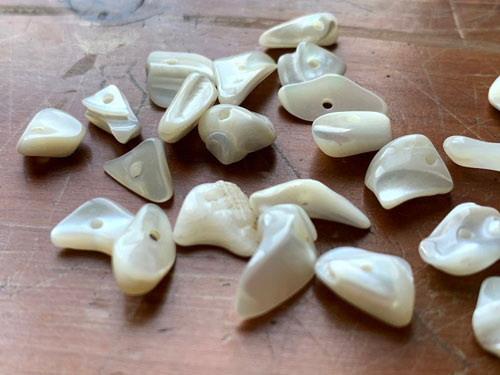
This lustrous look is due to the way in which the light reflects on the nacre layers. The luster is also known as the orient. With time, the mollusks secrete nacre whose layers smoothen the internal surface and block any irritants from latching onto the surface.
Mother of pearl is formed when small stone and crystal particles combine in shelled beings. It is typically composed of aragonite, which is a kind of calcium carbonate. Fragments of aragonite hexagonal plates get together with conchiolon or conchin in varying or set layers.
Conchiolin refers to an organic material that binds the aragonite crystals. The layers are added over time, due to which many layers accumulate. Thus, these layers are tough and resilient.
The combination of conchiolin and calcareous aragonite mineral acts as the building block of nacre or mother of pearl. The aragonite mineral crystallizes, and the corresponding crystals are likely to be tabular, needle-like, or prismatic.
Shells having the mother of pearl are present in both sweaters and freshwater. Still, they are likely to vary in terms of type. The gemstone features a shining creamy white color as well as a smooth texture.
It is usually opaque to translucent in look and is characteristically white, off-white, or cream. Nevertheless, you may also find it in other colors such as pale pink, silver, gray, black, red, yellow, and blue-green shades. Still, it is common to see these gems in white tones and pale pink shades.
The color directly relies on the type of mollusk. For example, abalone is known for its ability to deliver the most colorful and radiant varieties. It typically renders purple, green, and blue shades.
On the Moh’s hardness scale, the gemstone rates between 3 and 4. This means that the mother of pearl is quite soft. Despite this low Mohs rating, the stone is quite durable as well as wearable. A good level of durability comes from the way in which the nacre is formed. There is no cleavage, which means it is not easy for the stone to chip or fracture.
Metaphysical Properties
Mother of pearl is recognized as a stone of protection as well as healing powers. Due to its natural ability to protect, the stone is believed to have healing powers. It can calm down a stressed mind. A soothing or relaxed feeling is triggered once you wear or hold this gem. Even at the time of fear, this stone works to calm one down.
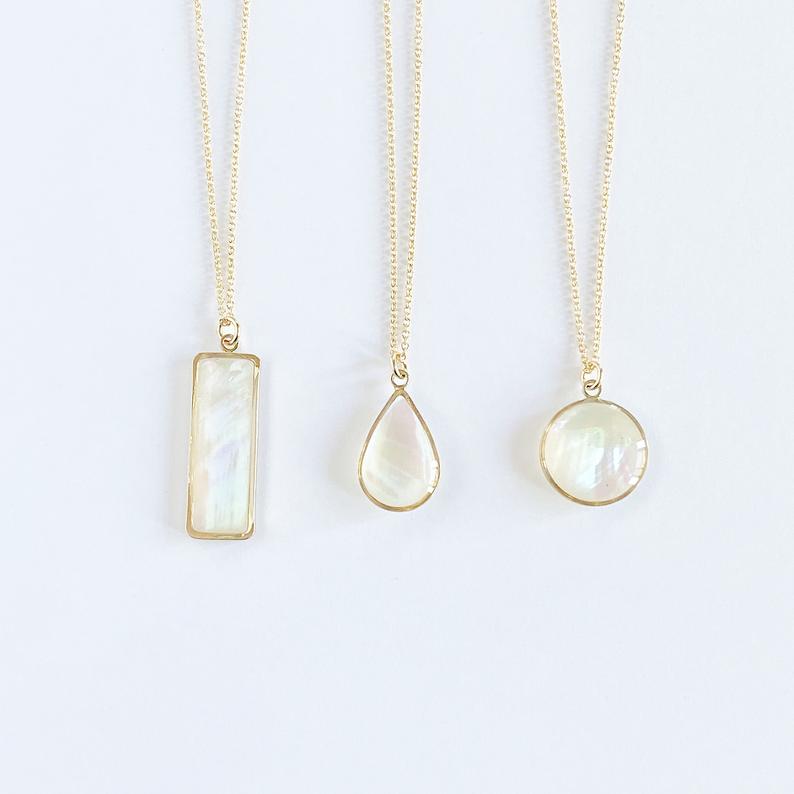
The healing powers are believed to come from the sea where this lustrous gem is formed. Mother of pearl is also known to kindle one’s imagination, insights, adaptability, creativity, and sensitivity. It aids in sustaining harmony and balance amongst different emotions.
The stone can even help in expressing your feelings of adoration and respect with ease. You can even try it to experience how it helps in making decisions with clarity. The stone is also believed to be useful for endurance, enhanced home life, and better organization.
The stone is also known to strike a balance and improvise harmony among the physical, emotional, and spiritual realms. In Feng Shui, the gem symbolizes good fortune and wealth. Thus, it is a common practice to gift this stone to ensure good luck.
Where to buy Mother of Pearl
Usually Etsy or Amazon is a good idea. Etsy is the leading online global marketplace of handmade, vintage, and creative goods. Amazon is one of the largest global online marketplaces. Both of them are reliable and easy to find your favorite items there.
Mother of Pearl in jewelry uses
In the world of jewelry, the term, mother of pearl, interestingly does not mean all nacre layers, including the coating of a pearl. Rather, it means the nacre that covers the internal layer of the shell of a mollusk. When set into any piece of jewelry, the gem is composed of just a fine layer of sediment akin to a boulder opal. It is this fine layer that is usually cut or carved to get shapes like cabochons.
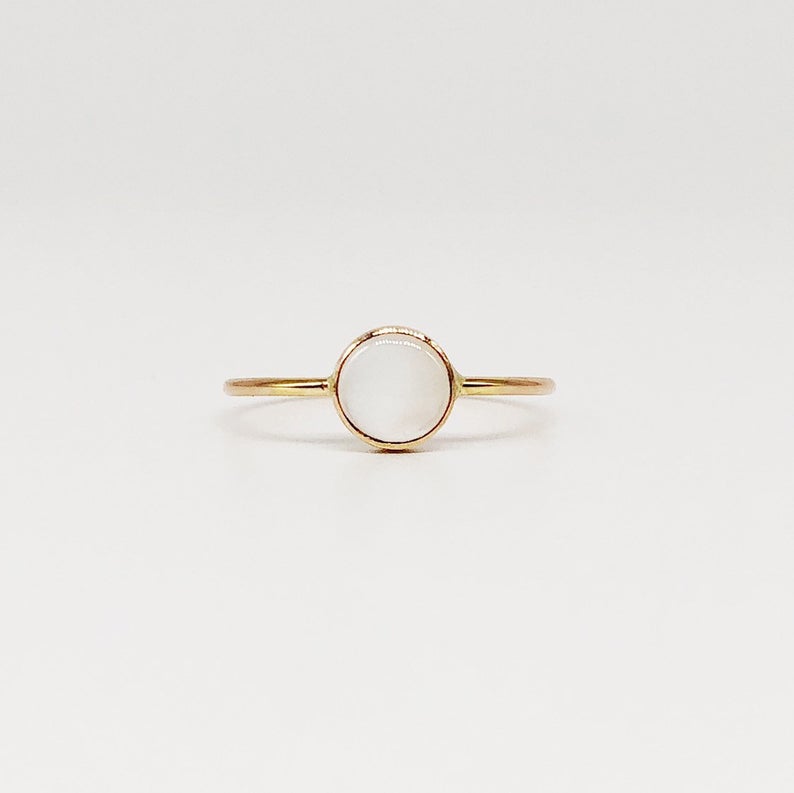
Just like pearls, the jewelry made using the mother of pearl belongs to the organic jewelry group. This means that this type of jewelry has its origin in a living creature such as an organism or a plant. Mother of pearl jewelry is likely to feature larger focal bits than pearls in pearl jewelry, as it covers the whole interior of the shell. In other words, the mother of pearl jewelry pieces are larger, focal pieces. Mother of pearl is mostly seen in fine jewelry pieces.
The gemstone placed in a jewelry piece is likely to be somewhat round and quite slim. One of its ideal features is versatility. Fit for wearing during the day and night, mother of pearl is a preferred jewelry stone for parties, weekend hangouts, formal occasions, and special events.
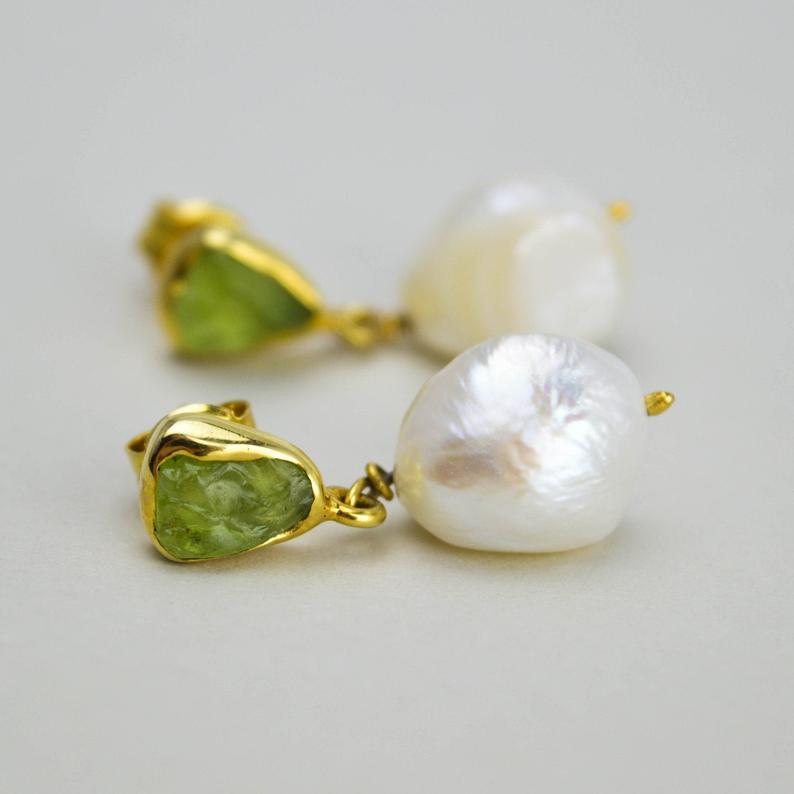
The highly versatile nature of this gemstone makes it fit for several jewelry applications. A designer can use it in various ways, such as in free shapes, carvings, and inlays.
Due to the neutral hues, mother of pearl goes well with all metallic colors. When used with rose gold or yellow, it appears rich and chic while rendering a stylish contrast feel. Another best part of this gemstone is that it can lend to any jewelry style.
Regardless of whether chic, casual, boho, or incredibly sophisticated, mother of pearl blends in perfectly. However, most of its jewelry pieces reflect a boho-chic appeal.
Mother of pearl jewelry is an ideal add-on to any attire, whether it is casual, formal, or smart. You are bound to add a discreet glow to any attire with its stunning pendants, necklaces, earrings, and rings.
Where does Mother of Pearl come from
Natural shells having the mother of pearl are found across the globe. They are more abundant than pearl shells. This is logically true, as the mollusks forming pearls shall always contain a shell but shall occasionally have a pearl.
Present in the salted and fresh water of the different water bodies, mother of pearl shells are found in Southeast Asia, Australia, Japan, the Philippines, China, Madagascar, the Gulf of Mannar, Myanmar, Europe, French Polynesia, Central America, North America, South America, the South Pacific islands, and the Persian Gulf.
How much is Mother of Pearl worth
Due to its abundance, the mother of pearl is quite affordable. It is even more affordable than pearl, due to which many consider it a budget substitute when it comes to buying jewelry. In this sense, this gemstone is not that highly valuable.
There is much demand for this gemstone in Europe, as it is primarily used in watch dials and buttons on this continent. Interestingly, it is common to spot costly mother of pearl jewelry, especially a set of necklaces and earrings demanding thousands of dollars.
Thus, while buying its jewelry, the prices are likely to range from a few to thousands of dollars. This is because several factors tend to affect the price, such as the age of jewelry, materials of jewelry, and the quality of craftsmanship.
A pearl occurring naturally is costlier than a naturally-occurring mother of pearl, as pearls are relatively and considerably rarer. It is like this: All mollusks producing nacre will contain a mother of pearl within their shell but not necessarily a pearl that can be embedded into a piece of jewelry. Nevertheless, out of them, just a small percentage of them shall contain a small foreign particle to reach inside the shells to form pearls.
Manmade mother of pearl and pearls are obviously significantly less pricey than their natural equivalents. Still, the big artificial pearls are likely to be costlier than the identical mother of pearl stones because of the prolonged time they take to come in shape.
How to use Mother of Pearl
It is true that the mother of pearl is mainly used in making jewelry. However, it is also a fact that people have used it for several other purposes. Home artists tend to use it often for home décor, usually as an embellishment in a mosaic tile design.
The gemstone is also used to highlight the different musical instruments such as accordions, guitars, and harmoniums. Lastly, you will usually see the mother of pearl on the outfits, such as in buttons and cufflinks. Just as with most healing crystals as well as stones, you should wear a mother of pearl close to your skin.
If possible, let it directly contact your skin. This is because it will absorb the vibrations of the gem more effectively. Do wear the stone if you are depressed or experiencing a sense of rejection or desertion. Mother of pearl also aids you in handling discontented emotional or physical needs.
It also aids in coming out of unbalanced emotions. Ensure to keep this stone with you when you find it hard to express your emotions or feelings. Keeping this stone near you at all times shall guard you against all negative powers, while making you recall the deep ocean of love dwelling in you.
How to cleanse Mother of Pearl
This gemstone can dull or become yellow with time as well as inadequate care. Thus, it is essential to take proper care of the stone or jewelry so that it remains radiant for a long time.
After removing the jewelry from the body, wipe it using a lint-free cloth so that all body oils as well as sweat get absorbed from it. If left on the stone or its jewelry, these residues can trigger a dull look.
To clean more effectively, consider dampening the cloth. For a profound cleaning, you should consider using a jewelry cleaner that is suggested for pearl jewelry.
However, a mixture of warm water and mild soap will also do the job well. If essential, do not hesitate to take the stone or jewelry to a qualified jeweler for detailed cleaning. Following are some don’ts or points to avoid when it comes to cleaning mother of pearl:
- Using baking soda or ammonia for cleaning
- Exposing to heat or direct sunlight, as these factors can easily dull mother of pearl
- Using abrasives or harsh cleaners that are likely to harm the stone’s surface by resulting in scratches
- Using ultrasonic cleaners that would surely harm the stone, as it is too soft to handle the force from these gadgets
- Wearing jewelry while participating in energetic or water-based activities such as cleaning and swimming
- Exposing to perfumes, hairsprays, or cosmetics, means putting your jewelry last after applying everything else
- Keeping in a sealed box or plastic bag, or else, moisture can get inside to harm the nacre
As this gemstone can quickly scratch, it is advisable to store it separately instead of with other objects. Consider keeping it in another pouch or box lined with fabric while ensuring that no moisture will be around.
How to inlay Mother of Pearl
Each shell of the mother of pearl is distinct in terms of texture and color. Its glimmering finish makes it an ideal material for embellishment, particularly as an inlay in metal items and wood furniture. Before inlay, this brittle gem is cut and routed.
A suitable saw is sharpened by hands to effectively cut the gem to get different designs. Each design is then drawn on the corresponding shell or a paper sketch is stuck to it for ensuring accuracy. It is then cut by considering the pattern, color, and curvature of the shell so that the effort to arch on each piece is reduced.
For cutting, a hole is first made into the shell, which marks the place where the saw shall initially strike. The design is cut by moving the tool perpendicularly against the shell. Each obtained design is then sanded to get rid of saw-induced rough edges.
The design is then thoroughly set on the surface to be inlaid. This is usually done with the help of water-based glue, which also helps in accurately tracing their outlines. Then, the chunks of mother of pearl are removed without harming them in any way, and a small router carves a narrow silhouette onto the wooden surface.
Now comes the process of inlay. Each piece of the gem design is reordered into the carved outline. Usually, a fine sawdust tool acts as a filler beneath the design to remove cavities induced due to the irregularities of the gem.
Then, a hammer helps in fitting each chunk into the wood after which the design is glued. The full inlay design is finally sanded to take off surplus glue as well as eradicate any uneven spots.
Comparison with Similar Stones
It is common for pearl fans to compare the mother of pearl with pearl and other stones. However, the mother of pearl is distinct. Let’s understand this fact by making a fair comparison.
Mother of Pearl vs. Pearl
Do you think that mother of pearl is better than the pearl, as the former’s name includes the word, mother? Well, stop thinking so, as it is not true. Mother of pearl is a different type of gemstone despite both being made of the same material and obtained from the same being. The differences lie in the manner in which they are formed and cherished.
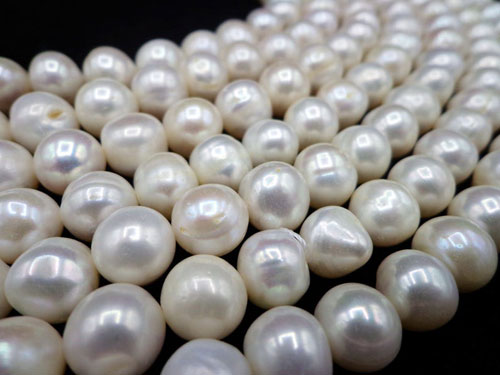
In terms of location, the pearl is formed within the mollusk’s tissue, while the mother of pearl is found on the shell’s inner lining.
In terms of shape and versatility, pearls are small and are seen around a bead or nucleus due to which they have a round shape. However, some pearls have baroque or random shapes. On the other hand, the mother of pearl is big and takes the shell’s shape. For making jewelry, designers utilize the mother of pearl in numerous ways due to its size and shape, which makes it more versatile than pearl.
Aragonite crystals, which are the building blocks for both gems, are tabular in the case of pearls. This is expressed in the beads’ structure. Layer by layer, the thinnest tabular crystals get deposited around each other, which are then retained together by conchin.
In terms of value, pearls are always valued higher than the mother of pearls due to their rarity.
In terms of thickness, pearls are thick gems but the mother of pearls is thin.
In terms of usage in jewelry, pearls are typically drilled and threaded; they are not set unlike the mother of pearl. Certainly, pearl jewelry has gained a higher level of elegance and luxury than the mother of pearl jewelry. Pearl jewelry is strung by adding several matching gemstones.
Mother of Pearl vs. Abalone
It is true that both these materials are used interchangeably but each one is pretty different from the other. Also known as a marine mollusk, Maori paua, or ormer shell, abalone is a kind of aquatic snail. It is known for its stunning shell.
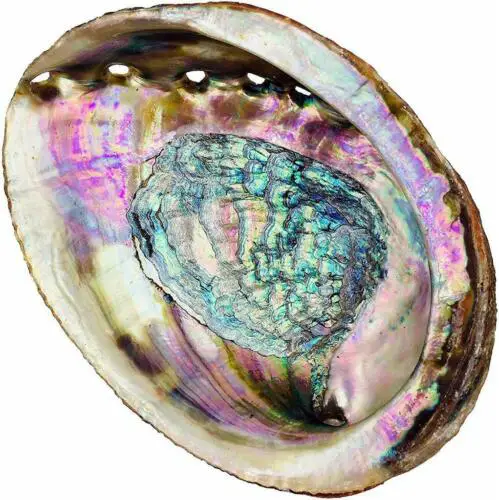
The colors of these shells are strong, vivid, and extremely iridescent. These shells have a spiral arrangement containing several respiratory pores close to the external edge.
Abalone is one of the sources of the mother of pearl, as it is a type of mollusk secreting nacre. So, in this sense, it is just like the oyster. However, it is rare to spot it, due to which it is highly valuable.
The best combination to use with Mother of Pearl
If you wish to fortify the defending energies around you, consider using mother of pearl with agate, ruby, jade, or malachite. It is also recommended to use it with garnet, petalite, jet, tigers’ eye, yellow jasper, aquamarine, and rainbow moonstone for harnessing the power of the gem’s energies in a more effective way. If you intend to fight against a skin disorder, it is recommended to use this gemstone with blue lace agate, aventurine, carnelian, or fancy jasper.
Final Words
Sourced from pearl oysters and abalone mollusks, the mother of pearl is lustrous, durable, and versatile. It is available in different colors, although white and pink shades are more common. The gem is extensively used as an inlay not only in jewelry pieces but also in furniture, watches, and musical instruments. Jewelry pieces will usually have a big chunk of set mother of pearl. The gemstone is recognized as a stress reliever, as it tends to calm and soothe negative emotions.